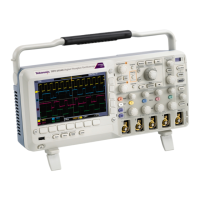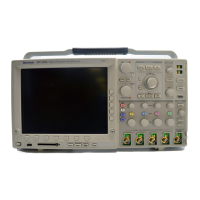Do you have a question about the Tektronix DPO5204 and is the answer not in the manual?
Details the product warranty terms, duration, and coverage.
Procedure for requesting warranty service, including notification and shipping.
Essential safety measures to prevent injury or fire hazards.
Guidelines for correctly connecting and disconnecting probes and leads.
Instructions for proper grounding and adherence to terminal ratings.
Safety measures for operating the instrument, including covers and failures.
Safety instructions for wet/damp, explosive atmospheres, and ventilation.
Lists Electromagnetic Compatibility (EMC) standards the instrument meets.
Details electrical safety standards and certifications.
Specifies instrument setup, environmental, and dimension requirements.
Procedures to protect the instrument from electrostatic discharge.
Instructions for powering the instrument on and off.
Description of front panel controls, ports, and indicators.
Description of connectors and ports on the side and rear panels.
Overview of the user interface, menu bar, toolbar, and display areas.
Explanation of front panel controls for various instrument models.
Steps to perform signal path compensation for accurate measurements.
Procedure for connecting probes and setting up analog input channels.
Functionality to quickly return the instrument to factory default settings.
Procedure for automatic setup of acquisition, horizontal, and trigger.
Explanation of different acquisition modes like Sample, Peak Detect, and Average.
Fundamental concepts of trigger events, modes, and holdoff.
Procedure for selecting and configuring various trigger types.
Using main (A) and delayed (B) triggers for complex signal capture.
Procedure for taking automated measurements on waveforms.
Procedure for comparing signals against predefined masks.
Procedure for comparing signals against defined limits for pass/fail testing.
Steps to create custom control windows with frequently used functions.
Details the product warranty terms, duration, and coverage.
Procedure for requesting warranty service, including notification and shipping.
Essential safety measures to prevent injury or fire hazards.
Guidelines for correctly connecting and disconnecting probes and leads.
Instructions for proper grounding and adherence to terminal ratings.
Safety measures for operating the instrument, including covers and failures.
Safety instructions for wet/damp, explosive atmospheres, and ventilation.
Lists Electromagnetic Compatibility (EMC) standards the instrument meets.
Details electrical safety standards and certifications.
Specifies instrument setup, environmental, and dimension requirements.
Procedures to protect the instrument from electrostatic discharge.
Instructions for powering the instrument on and off.
Description of front panel controls, ports, and indicators.
Description of connectors and ports on the side and rear panels.
Overview of the user interface, menu bar, toolbar, and display areas.
Explanation of front panel controls for various instrument models.
Steps to perform signal path compensation for accurate measurements.
Procedure for connecting probes and setting up analog input channels.
Functionality to quickly return the instrument to factory default settings.
Procedure for automatic setup of acquisition, horizontal, and trigger.
Explanation of different acquisition modes like Sample, Peak Detect, and Average.
Fundamental concepts of trigger events, modes, and holdoff.
Procedure for selecting and configuring various trigger types.
Using main (A) and delayed (B) triggers for complex signal capture.
Procedure for taking automated measurements on waveforms.
Procedure for comparing signals against predefined masks.
Procedure for comparing signals against defined limits for pass/fail testing.
Steps to create custom control windows with frequently used functions.
| Bandwidth | 2 GHz |
|---|---|
| Channels | 4 |
| Input Voltage Range/Maximum Input Voltage | ±40 V |
| Vertical Resolution | 8 bits |
| Input Coupling | AC, DC, GND |
| Interface | USB, LAN, GPIB |
| Operating Temperature | 0 °C to +50 °C |
| Trigger Modes | Edge, Sequence, Pulse Width, Timeout, Runt, Logic, Video |
| Sample Rate | 10 GS/s (All Channels) |
| Display | 12.1 in. (307 mm) LCD |
| Input Impedance | 1 MΩ ± 2% // 15 pF |











